Former publisher tells the history of ‘Nevada’s only African-American community paper’
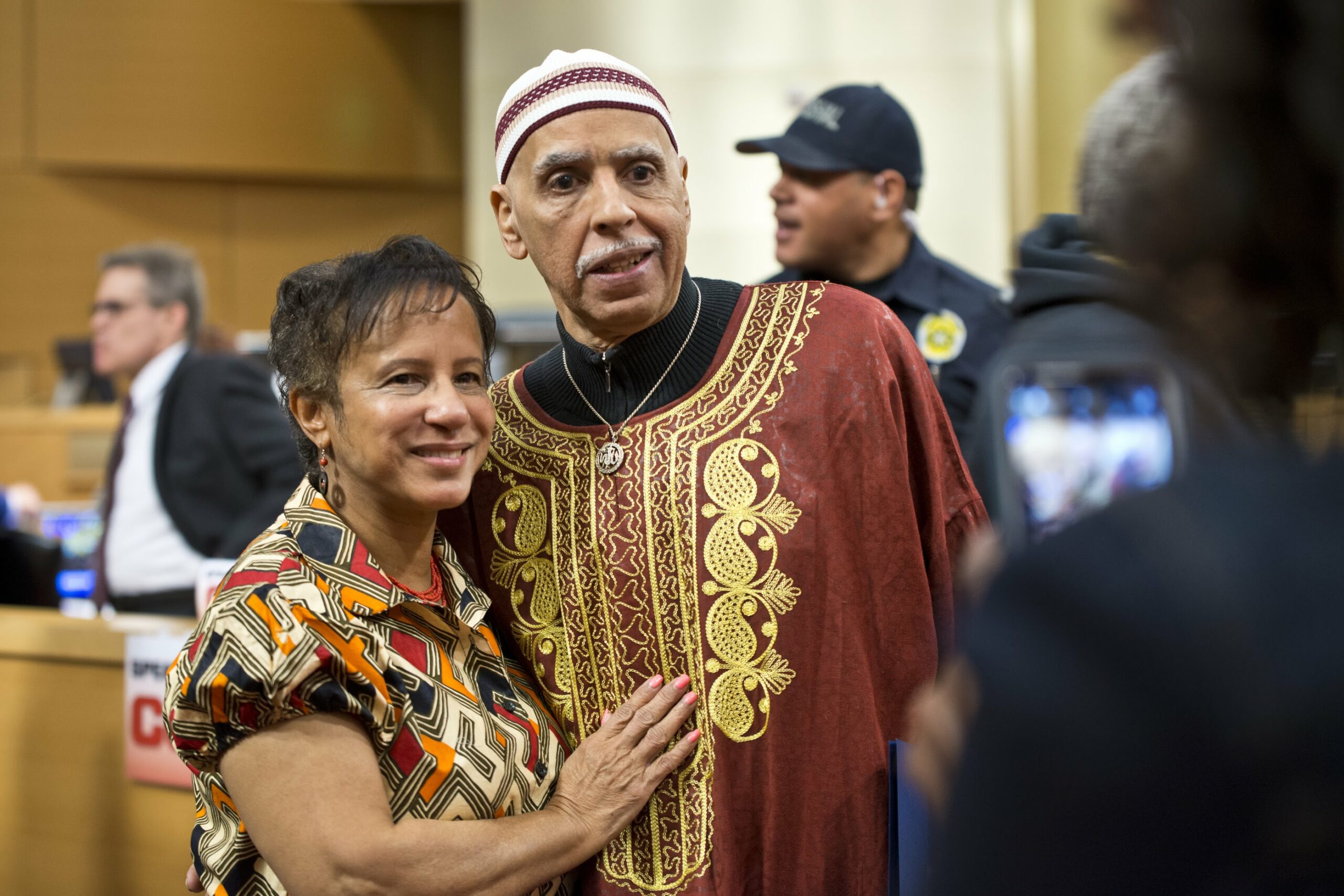
Nevada used to have a newspaper with stories geared toward its black community.
But that ended six years ago when the last issue of the Las Vegas Sentinel-Voice went out in January 2014. Publisher Ramon Savoy decided to close the paper, self-described as “Nevada’s only African-American community newspaper.”
Savoy said he skipped writing the typical editorial explaining why he was closing, which created “more buzz than anything.” The 65-year old Harlem native, radio personality and journalist whose contributions over a quarter century were recently recognized through a formal proclamation by the City of Las Vegas last month believes it didn’t mean the end of storytelling in Las Vegas’ black community.
“I felt like understanding the integrity of the paper was number one. I didn’t want somebody to get it who maybe had an agenda or was going to use it and have that old Stepin Fetchit-type of mentality of what they would do with a black paper,” Savoy said. “If the Sentinel’s not around, just start your own paper! And that was my reckoning, you know — you don’t need the Sentinel.”
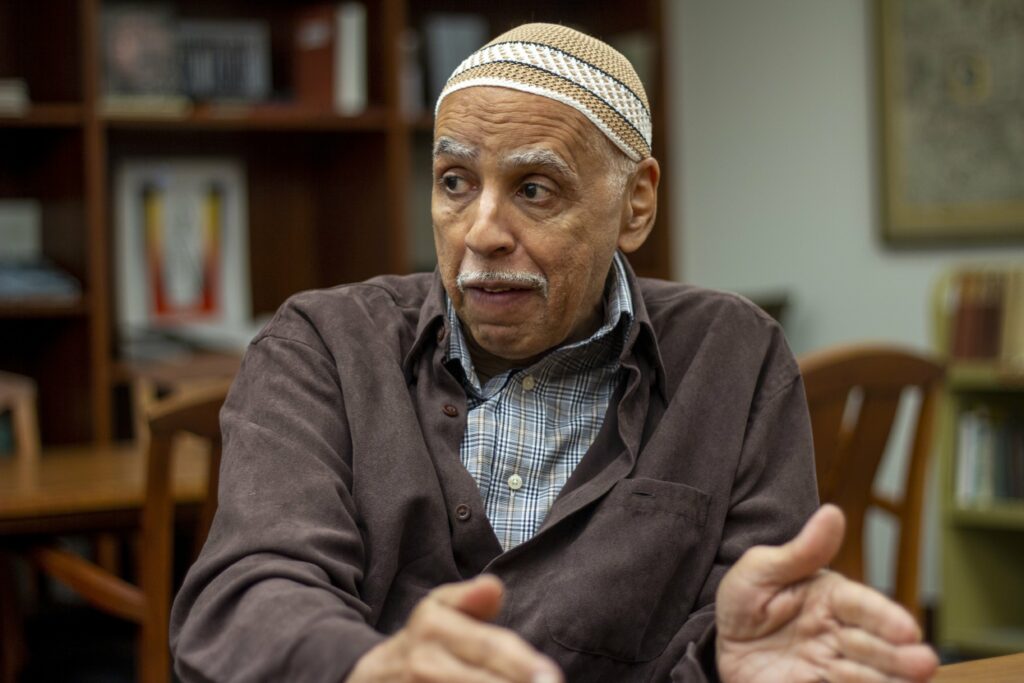
There were no eligible successors, he said while referencing Stepin Fetchit, a character played by “Hollywood’s first black film star” Lincoln Perry. Playing the lazy and witless Fetchit tarnished Perry’s reputation for some who saw the character representing black people as easily distracted and somewhat incapable of improving themselves and their communities.
The Las Vegas Sentinel-Voice is no longer feeding “news-hammering information,” and national and local stories of importance to African Americans. Weekly editions from 1982 to 2014 are archived in print and microform, available for the public to view at UNLV Special Collections.
Savoy continues keeping the community informed by co-hosting the weekly radio show “Like It Is” on KCEP, a Vegas-based station that focuses on African Americans with talk radio segments and music. He and his co-host interview politicians, educators, entertainers and other people “relevant to the community” during the show’s one-hour segment on Fridays.
Last month, the Las Vegas City Council proclaimed Feb. 4, 2020 as Ramon Savoy Day to recognize him for his role in documenting local and national news, and making waves in the community.
After an introduction by Councilman Cedric Crear, Savoy greeted City Hall with a traditional Muslim greeting which means “Peace be upon you,” in English.
“As-salamu alaykum ... You have an opportunity just as I have an opportunity to make a difference, and not to shy away from it,” he said during the City Council meeting in February.
Getting the information out on the streets has been a driving force behind Savoy’s activism. In 1991, he started in sales and took on reporting, editing and distribution of the Sentinel-Voice, a free weekly that circulated about 30,000 copies throughout Las Vegas and expanded to Reno, Carson City, Tonopah and Hawthorne.
When it came to a target audience, the area more commonly known as Las Vegas’ “Historic West Side” neighborhood was the newspaper’s “bread and butter,” Savoy said.
Savoy started getting to know Las Vegas’ West Side neighborhood while stationed at Nellis Air Force Base from 1978 to 1984. After six years of service he knew the lay of the land, which gave him an eye for ad space.
Some store owners were more willing than others when Savoy asked whether he could set up a magazine rack for the Sentinel-Voice.
“When they’d say ‘Oh, we don’t have that many black people,’ [I’d say] you’ve gotta understand something, this is how you get to know what black people are thinking,” he said. “How do you know what’s important to us?”

89106 was the ‘bread and butter’
African Americans have a history of enterprise and contributions to all of Las Vegas’ industries. Drawn by the railroad, gaming and federal projects including Hoover Dam, they began settling in Las Vegas in the early twentieth century.
As Vegas’ population continued to grow, black newcomers were increasingly confined to settling on the west side of the San Pedro, Los Angeles & Salt Lake railroad tracks because of pressure from the Las Vegas Land & Water Company, an agent of the Union Pacific. City officials could also use segregation tactics such as granting business licenses for black applicants only for locations on the West Side.
The implementation of Jim Crow laws in the 1930s also led to lasting segregation effects. According to 2010 data from the U.S. Census Bureau, 40 percent of residents in 89106 were African American compared to 11 percent in Las Vegas.
The neighborhood today rests mostly west of downtown and contains more than 700 public housing units dating back to the 1950s, as well as Valley Hospital Medical Center and the Las Vegas Metropolitan Police Department headquarters to the southwest. In the northeast there is Doolittle Community Center and Berkley Square, a historic subdivision that originally had 148 “contemporary ranch-style” homes designed by African American architect Paul R. Williams in 1949.
Restaurants, clubs and entertainment thrived in the 1940s through the ‘70s, but the West Side has not developed at the same rate as other suburban neighborhoods. Some locals blame the lack of development on unwillingness to invest or lack of coordination between the community, city and county to go forward with a lasting development plan.
Savoy moved to Las Vegas in the late ‘70s and noticed that the West Side’s neighborhood and its residents were neglected compared to the Strip and other parts of town. The underlying reason did not appear to be systematic “redlining” — the practice of denying loans to black residents and businesses — but rather a lack of interest in the area.
“It wasn’t necessarily redlining, but there were no actual dollars coming into the community for development,” Savoy said. “How are we going to improve our area if we don’t have it developed?”
Savoy saw media — both print and radio — as a way to awaken the West Side’s community members and in turn, revitalize the neighborhood.
Broadcasting from Harlem to Las Vegas (1978 to 1996)

Born in Harlem on April 24, 1954, Savoy’s love of media started at a young age. He remembers when new technologies in audio recording changed his world.
“I remember I was the first kid on my block to have a cassette recorder — because that was the thing, being able to record the music,” he said.
“Reel-to-reel” tape players or 8-tracks were common when he was younger, but they didn’t allow for easy recording or mixing of audio, which is crucial for making original music or playlists.
“It was carrying the turntables, then carrying 45s and then when the cassette came out — a Lloyd cassette recorder, that was like heaven,” he said.
Playing with the recorder and making playlists evolved into DJ gigs when Savoy was a teenager, and followed him to college. He attended the City College of New York in 1972 and started working at their radio station. With cable TV growing in popularity in the early ‘70s, Savoy found himself at the intersection of radio and TV broadcast.
While Savoy was getting his feet wet in Harlem’s radio broadcasting scene, Dr. Charles West, founder and publisher of the African-American paper the Las Vegas Voice, was getting ready to sell his paper.
The Voice started in the 1950s and had a circulation of about 10,000 copies with a weekly black history column, feature on Africa, world news, editorials, church news and gossip sections. From the time West sold it in 1975 to its acquisition by Ed and Betty Brown in 1982, the paper changed ownership three times.
The Browns, who founded the Las Vegas Sentinel in 1981, bought the Voice in May of 1982 and merged the two papers in November, creating the Las Vegas Sentinel-Voice.
When the Sentinel-Voice started hitting the streets, Savoy and his wife Lynnette had been Las Vegas residents for four years. The couple married in New York in 1978 and had three sons while Savoy was stationed at Nellis Air Force Base 1978 to 1984 as a jet refueler and technician.
Savoy said he preferred swing and graveyard shifts while he was in the Air Force because they allowed him to juggle part-time jobs at the Sears parts department and an advertising company during the day.
The off-schedule also allowed him some space to avoid being harassed by other airmen who sometimes commented on his appearance. Because Savoy was a Muslim, he had a shaving waiver that authorized him to have a “light beard” although the other servicemen were required to be clean-shaven.

“Nellis Air Force Base had important people … so I wasn’t really meant to be seen because I didn’t represent what the service was,” he said.
He characterized instances of discrimination as mild and added that he was on average 3 to 7 years older than many of the people he worked with. He didn’t buy into the “beer buddy” culture of many of the younger people in the air force at the time — he already had a family and was “pretty much experienced in life in New York,” he said.
As he was wrapping up his six years of service in the Air Force, Savoy was working as a jockey for UNLV’s public radio station and in sales at KCEP, where he met the Browns.
Ed Brown passed away in July 1988, and his wife had been trying to keep the Sentinel-Voice “afloat,” Savoy recalled. While working in sales at the noncommercial radio station KCEP, he would pitch the newspaper’s ad space as a “one-two punch” marketing strategy.
Per federal law, noncommercial stations may list information about a guest or donor but they are not allowed to explicitly advertise or list a price if they were having a sale, for example. The Sentinel-Voice was a platform separate from the radio that allowed the radio station’s clients to advertise more explicitly, he would tell them.
Although Savoy didn’t directly depend on the welfare of the paper at that time, he still felt compelled to make sure the paper was being printed.
“The importance was making sure the revenue stream went into black media,” he said.
His involvement escalated from sales to distribution in a matter of weeks and to reporting and hiring freelance writers over the years. After five years of being involved in every step of publishing the Sentinel-Voice, Savoy acquired it from Ed and Betty’s son and then-publisher Lee Brown in November 1996.
Change agent for the African American community
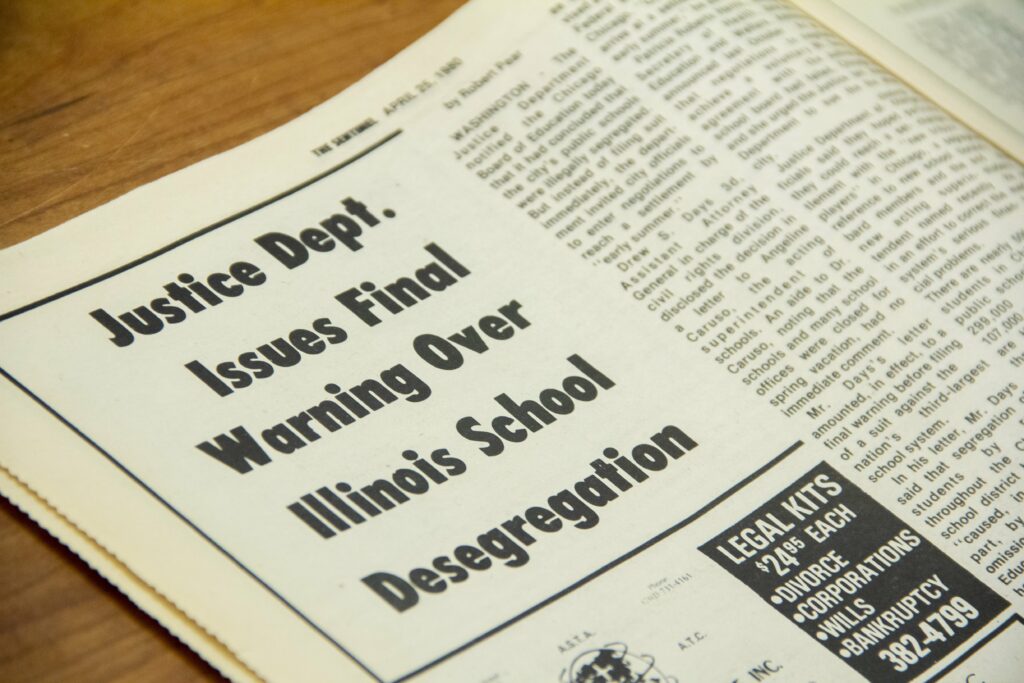
The Sentinel-Voice told stories that mattered to African Americans not just in Las Vegas but across the country with headlines like,
“Oakland police officers sue alleging discrimination,”
“Worsening racial situation erupts in South Africa,” and
“Justice Dept. issues final warning over Illinois school desegregation.”
Savoy would take a stack of papers to the prison in Indian Springs every week when he started. He stopped making the hour-long trip when he found out they weren’t being distributed to the inmates.
“The editorials were harder-hitting, so if you’re talking about the police, that gets them riled up,” he said. “The corrections officers and administrators were the ones keeping the paper up in the office and looking at it.”
Savoy said Brown “didn’t put any restraints” on what directions she wanted to take the paper before her death in 1995. Some public figures who had gotten used to advancing their own “agendas” in the paper’s editorials were taken aback when Savoy cut them off and then wrote less-than-flattering stories about them.
When Savoy took on sales in 1991, the Sentinel-Voice regularly published editorials from community figures such as Ray Willis, who was a spokesman for Clark County School District, or then-Nevada Assemblyman Wendell Williams. He put a stop to such editorials and initiated a shift from “soft” coverage of things like local beauty pageants, fundraisers and church events to tougher stories.
“We were not trying to sugar coat nothing, we were just trying to be straight up with it,” he said.
Filing through library archives of the paper, Savoy smiled fondly at stories he remembers getting “in trouble” for, such as one he wrote in November 1995 about a local restaurant that went out of business.
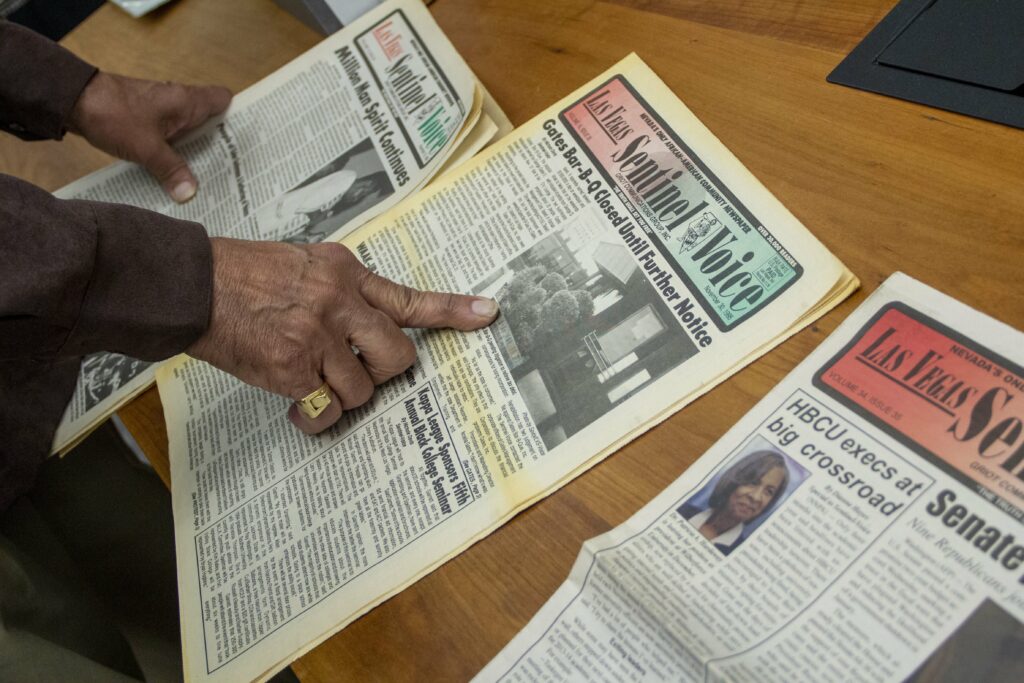
“I caught big heat for this one,” said Savoy, gesturing to a photo of a restaurant storefront and the headline “Gates Bar-B-Q Closed Until Further Notice.”
When the popular chain restaurant went out of business, Savoy tried to get an interview to write a story about why it closed. The owners never agreed to speak with him.
He said he showed up with a camera and got the story anyway, recalling that the owners got mad when they saw him photographing health and “non-payment” notices.
Savoy pointed out a front-page story written by Ed Brown in October 1996 about a local mosque leader or “Imam” Mujahid Ramadan. Several members of the Muslim community were asking the Imam to step down from his position for forging a check and mishandling mosque funds. Savoy used to worship at the mosque and recalled that Ramadan was a person of high standing and well-known in the community.
“I caught a lot of heat for that one because Mujahid ... his family went around and picked up as many papers as they could,” Savoy said.
Savoy wanted to develop the paper in a way that reflected his vision for the city’s black community — one of vitality and self-improvement, as he describes.
Alcohol and tobacco advertising did not fit into that vision. As a member of the National Newspaper Publishers Association (NNPA) and the West Coast Black Publishers Association, the Sentinel-Voice had access to a network of advertisers, but Savoy turned the newspaper away from those that were “not healthy” for the community.
“You know, we were writing these stories and we [were] trying to show we’re on the up and up and good for it, but then the next page had Johnny Walker or was selling cigarettes,” he said.
Savoy’s hardline stance on journalistic integrity has established him as a trusted figure of activism in the community. In addition to being honored by the Las Vegas City Council last month, he was recognized by Clark County at the Doolittle Community Center for his life’s work in the 89106 area zip code and is a recipient of the 2020 NAACP Legacy Award and NAACP Image Award.
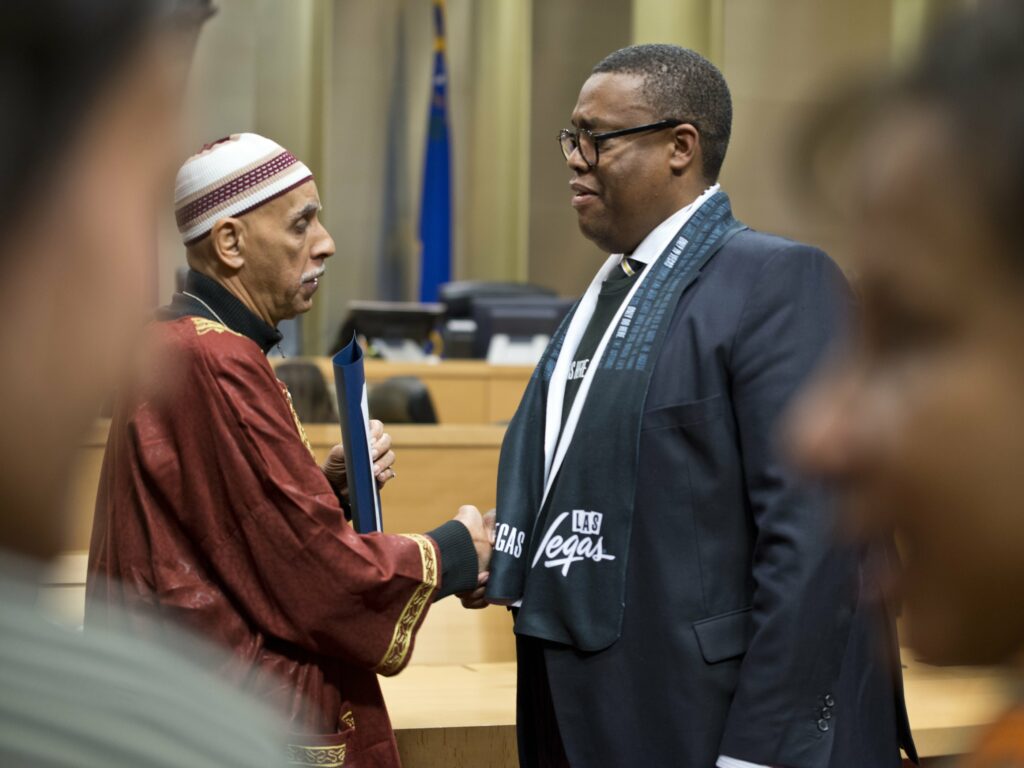
In his experience, the news can be an instrument of social justice — a “change agent” regardless of whether it’s on paper, radio waves, smartphone or a conversation over the dinner table. He believes that empowerment and justice depends on people being aware of what is going on around them.
“The drum is a very major thing when it comes to black people in Africa,” said Savoy, explaining an icon in the Sentinel-Voice’s nameplate. “What a Sentinel is, is bringing the law, bringing the news.”
Savoy warns that not transmitting that knowledge “creates a vacuum” and affects the larger community who depend on being informed in order to advocate for their rights and interests. As a member of an older generation, Savoy thinks it is his responsibility to take the lead in spreading the community’s stories — the good and the bad — to younger generations.
“It seems like it has to be something hard-hitting before younger individuals find the importance of what news is. It has to be, you know, the choking, the shooting and so forth — the injustices — before they want justice … It’s important to do this upfront, rather than on the back end,” he said.

This story was updated on March 10 at 7:39 a.m. to correct that University Medical Center is not inside of the 89106 zip code.
